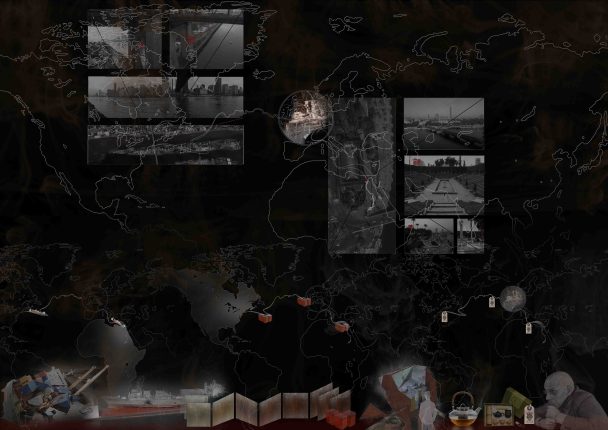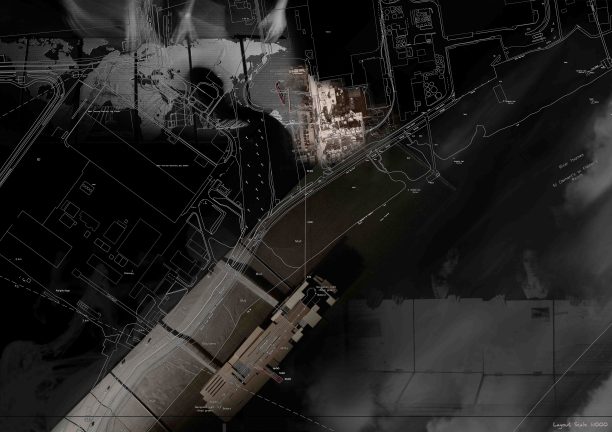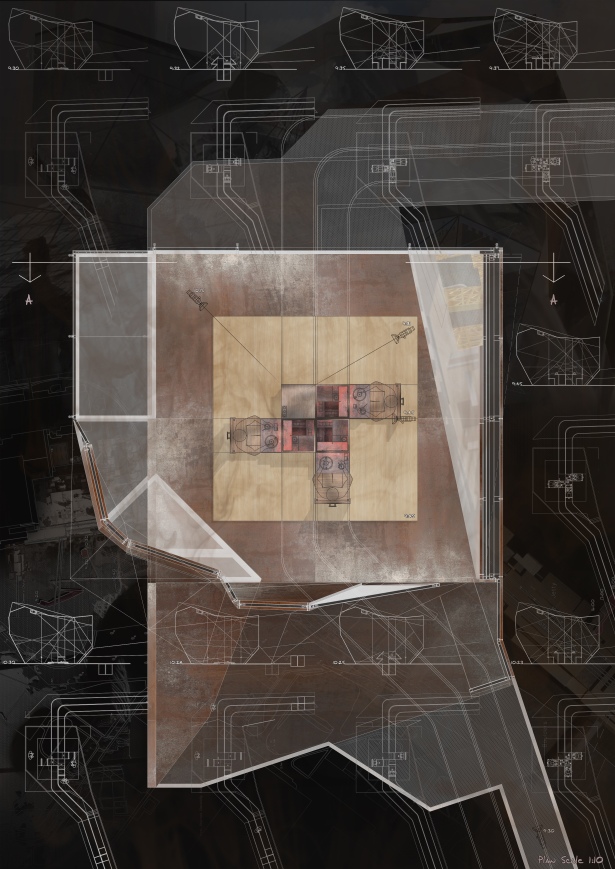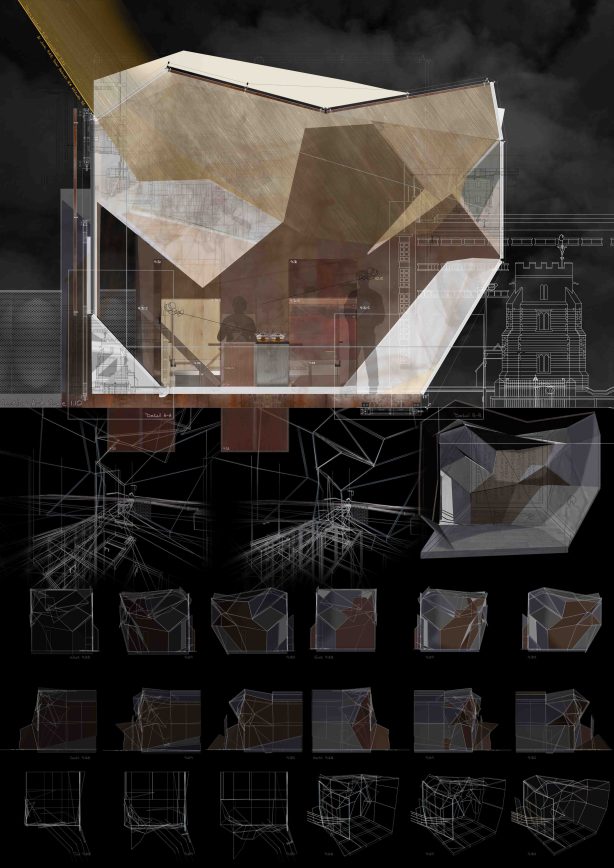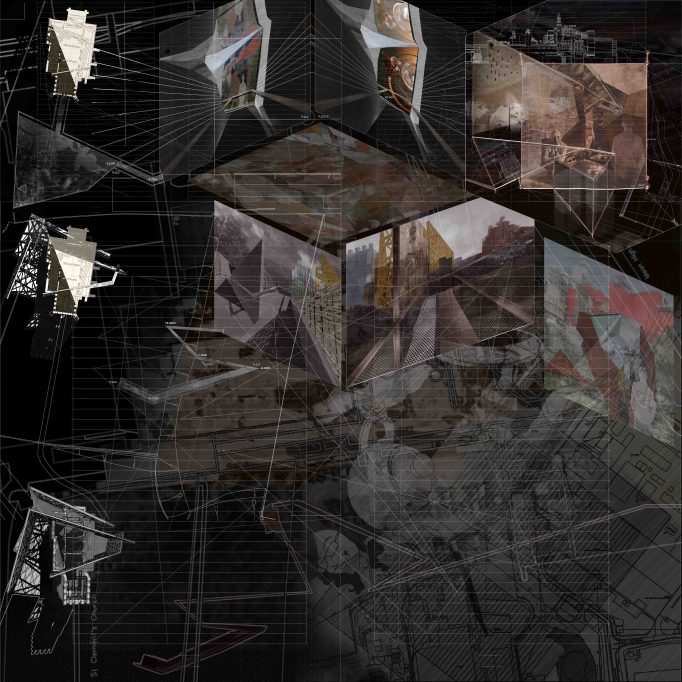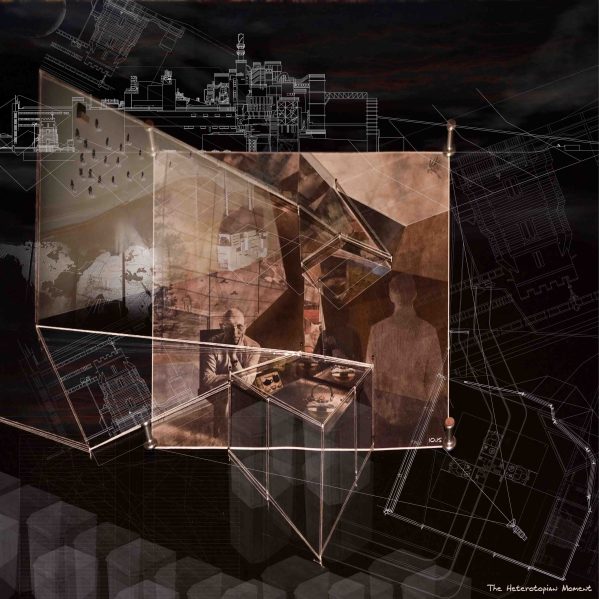Threading Fragements Via Heterotopia: Unfolding Frames of Local and Global Landscapes
Posted by Treveena in Uncategorized on January 24, 2012
I am a fragment linking architect; I work as part of a team
I am specialized in pecking hidden knowledge using the eye of Horus. The disparate fragments are linked in a system and that is reflected and criticized in the Other world behind the mirror. Heterotopia is used in creating multiple reflected outcomes to further see the imagined perceptions one could have and embody them in reality.
By freezing the moment of reflection, one can identify what is happening in a specific time. Heterotopia depends on knowledge which in turn changes with time and therefore different contexts are the outcome. There would be constantly a social space that is reversed and criticized by the reflector whether it was mirror or glass and that represents what is happening at that specific time.
I am specialized in creating spaces that are different from what surrounds them but yet stay linked to them. Further specialties are of creating juxtaposed spaces, places that collect bits and pieces of time but are out of time itself, closing and opening systems, and last but not least placeless places.
Reflecting the group journey
Being part of a group of six members, a journey started with a game of chance that included shifts in timing. The journey headed to Kielder forest and the movement cast on the way was reflected in an installation of used tea bags. At the Mirage installation by the forest lake, a tea sanctuary was placed facing the east. During this journey, my interest started with the notion of heterotopia which are spaces of otherness represented by the mirror and that opened the gate to the question of reflection and its representation. For the final outcome of the project, screens, glass, and mirrors were tools used to convey desired reflections.
The site near Tilbury was the starting point for a project that linked all six members fragmented there. There were guiding keywords that assisted the group and which were given at the beginning of the year. The most important keywords were balance, suspension, rain, pivot, electricity, water, and john cage. Furthermore, there was a main book as a guiding reference which was Angela Carter’s book ‘Nights at the circus’ which had interesting illusionary scenes in addition to the time games that influenced the whole project. There was a specific interest in two main aspects as part of the group which is the desired reflection and its relation to time. Nevertheless, the whole project is being threaded by the notion of heterotopia.
Tensions and Links
There is a constant tension between what happens in everyday life and what is arbitrary or different. This tension is seen in the project between the cube representing heterotopia and the tea event that happens inside it which is part of the everyday life. The ongoing tension creates a dialogue that captures the opposition between these two worlds and is similar to a pendulum that oscillates between being balanced and disrupted.
The project includes local and global aspects. The local one is having a gridded network of views on specified paths in the urban landscape with particular points that frame certain views. These views are related to the rest of the group members’ projects. As for the global aspects, the United Kingdom, Egypt, and the United States get connected via screens as well as material exchange systems. Shifts and movements occur as people travel (literally or metaphorically) from one place to another and more layered links are revealed on different scales.
The six principles of heterotopia are as follows:
First Heterotopian Principle
It is present in all cultures and this shows how broad the concept of heterotopia is. Foucault mentioned many examples but what is interesting is the prison as an example of his first principle. He talked about the Panoptican prison and the relation between power and the body and having said that, the designed cube acts as an optical machine that exerts its power and arrests the visitors, imprisoning them within its structure.
On the other hand, the tea event happens a while after the power of the cube has taken over those imprisoned inside it. It gives them a way to escape this heterotopic ‘emplacement’. Nevertheless, the reflecting mirrors of the cube disorient and try to destruct the harmony created by the tea ceremony and tries to pull it out via its exerted power. A tension is thus produced between the orthogonal setting of the tea ritual and the decomposed heterotopian cube.
Second Heterotopian Principle
It is to take an existing heterotopia and making it function in a different way. The example for this principle was the cemetery which has its own position yet linked to its surroundings. In the Tilbury site where the project is located, there exists an ancient small church with its cemetery, a complex huge factory, a garden with a natural path trail, and the Thames River with ships wondering in its reflecting waters. Such a heterotopic setting was taken into the cube and by fragmenting them, leads to a different function of the existing order. An intense fragmentation and dismantlement is a provision of the cube that transgresses to its death; A death that Foucault pleasurably desires.
In the midst of this disturbance comes the tea event with its notion of life and resurgence that opposes the death applied by the cube. By drinking the cup of Tilbury tea, one escapes the destined death allocated for the visitors themselves. Although the shards of the cube tend to destruct this moment as well, it is up to the visitor to either take control or surrender to the existing condition and powers overruling oneself.
Third Heterotopian Principle
The ability of juxtaposition is his third principle where in a real space, many ‘emplacements’ are overlaid and are likely to be different from each other. He gave the theater and cinema as examples for this principle clarifying that a sequence of unfamiliar places can be brought together. From this point, the project utilizes a screen that is located on one of the sides of the cube opening the gate to other places where the cube is repeated within difference. These places are in Cairo, Egypt and New York, USA. The three sites are globally connected and overlay each other in various ways but it is via the screens that this connection is related to this principle. The visitors see other people as their reflection, drinking tea in other parts of the world bringing their anthropological aspects into the cube.
Such global juxtaposition has its effect on the visitor to this cinematic pavilion tea house with them being the people performing on a stage for others to observe from other places. The tea event here is helping in performing what is sort of a Japanese ritual, an additional juxtaposition. In designing the layout of the tea event, the placement of the guests was similar to that of a Japanese layout. The modular system was taken as well as the places of the three guests and the host. Foucault’s comment on the painting of ‘Las Meninas’ was of special interest in terms of what was missing or unseen in it. In the project, the host is invisible being the designer serving the three guest visitors their tea. With this mentioned the tea event is thus incomplete and fragmented, leaving the visitors in a disruptive position of not having an ordinary tea for two (or four). However, this disturbance ends once the tea is served and the harmonious effect begins to coexist. But then again, the juxtaposition of power on the visitors occurs by that same screen since they become objects to be viewed at by others and tensions arise.
Fourth Heterotopian Principle
It is associated with ‘slices of time’ where it functions entirely when one is found in a complete break with the conventional time. Foucault gave two kinds of ‘heterotopias of time’ here. The libraries and museums were examples of piling up time continuously and eternally while opposite to that was the festive one which occurs for a limited time yet repeated every now and then. In the project, the cube operates in the latter heterotopian manner where time is of essence for the cube to transform during the day. It operates from 9:30 till 15:30 and this is broken down to one hour per each operation for the cube to start and end its heterotopian function.
While the cube is in control of the time for the people inside, the people are in turn in control of the time of having their tea. The tea event here is a tool for the visitor to escape and forget time by dissolving in the cup of tea that is drunk and refilled according to one’s need. It is no longer part of a slice of time but it is rather a continuous sense of solidarity that is saturated within. Nevertheless, the disturbance of the cube sneaks into the reflection of the tea drunk and makes all the attempts to impose itself even inside the very cup of tea. Although it was supposed to give the visitors an escape haven from all the disruption around, it is placed at some time under the control of the cube.
Fifth Heterotopian Principle
Opening and closing systems was the fifth point in Foucault’s principles. He mentioned two opposing systems where one is related to the simultaneous isolation and penetration while the other is of excluding the people entering. The project uses the latter for its opening and closing system where according to Foucault (Foucault, 1997) : “Everybody can enter into those heterotopian emplacements, but in fact it is only an illusion: one believes to have entered and, by the very fact of entering, one is excluded.” Nevertheless, the overlaying of the juxtaposed ‘emplacements’ via the screen inside this opening and closing system allows a penetration to a certain extent that is still in the cube’s controlling system. Then again, the same screen can increase the pressure and exclusion felt by the visitors by showing a playback of themselves on site and imposing Foucault’s power upon them. The cube’s surfaces operate in a system that opens and closes like origami so as to let each face reach its specific location within this unwrapped system. By that it would achieve its desired outcome that excludes and shifts people from the original context around them. Another reference that influenced this point in the project goes back to Trisha Brown. She defied the existing order of what would be a floor or a wall shifting that. The wall became to her a floor for a performer to walk on and that was interpreted in the design of the cube.
Within this tense exclusion, the tea comes in to liberate the visitors from it. It acts as an escape passage from this overwhelming system of imprisonment. It too has its opening and closing system which is of an orthogonal based system. It is contrary to that of the chaotic opening system of the cube which inscribes it and which has a dismantling and excluding effect in it. Both systems are dynamic in terms of their opening and closing but each has a different impulse on the visitor. The cube excludes by the illusion it crafted while the tea is more of a sanctuary within this disturbed atmosphere created by the surrounding faces of the transformed cube.
Sixth Heterotopian Principle
Is of creating an illusionary space where Foucault stated (Foucault, 1997) that such a space “that exposes all real space, all the emplacements in the interior of which human life is enclosed and partitioned as even more illusory.” The cube makes use of mirror fragments to create such an illusionary space. It fragments the factory and church in the site context and either inverts them or collages them in a different manner. It not only converts such real spaces into shards on its mirrored faces but it does that also to the people visiting this particular ‘emplacement’. It is worth mentioning that Eisenman made use of fragments deconstructed as well as the repetition within difference. In the project the cube is repeated in other sites worldwide yet different in its design as each reacts to its surrounding context in its own way. There is also a fragmentation within the cube itself. The tea event that could be considered a box inside a box and which is dismantled gives the notion of having fragments inside existing fragments. Both Foucault and Eisenman dealt with fragments and this is how it was performed in the cube. Moreover, there is an influence from the works of Diller Scofidio’s projects in general but there was one in particular where they used a mirror placed at a 45 degree angle. This mirror allowed them to create a unique performance as what was performed on the floor appeared to be one that is on a wall. This kind of performance that was real and imaginary was successful via the use of the mirror and was interpreted in the cube’s placement of some of the mirrors inside it to flip the performance project based at the church.
The tea comes in to bring the visitors back to their real life. It is something that occurs in everyday life and allows a relief to the visitors who got disturbed by the illusion of the cube. However, the cube continues on to disturb the tranquility of the tea event itself by the further breaking down of its parts into its faces. A constant dialogue of tension is created between the people drinking their tea and the surrounding illusionary context formulated by the cube.

